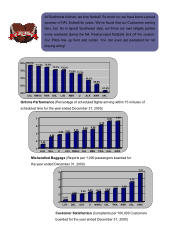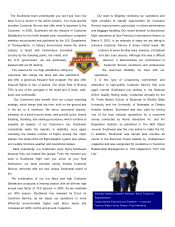Southwest Airlines 2000 Annual Report Download - page 20
Download and view the complete annual report
Please find page 20 of the 2000 Southwest Airlines annual report below. You can navigate through the pages in the report by either clicking on the pages listed below, or by using the keyword search tool below to find specific information within the annual report.
MANAGEMENT’S DISCUSSION AND ANALYSIS
OF FINANCIAL CONDITION AND RESULTS OF
OPERATIONS
YEAR IN REVIEW
Southwest posted a profit for the 28th consecutive year and
a record annual profit for the ninth consecutive year. This
excellent financial performance was achieved despite the
highest jet fuel prices since 1990. Operating revenues and
operating income were the highest in the Company’s history.
Southwest’s margin performance was the best in 20 years
with an operating margin of 18.1 percent and net profit
margin (before the cumulative effect of a change in
accounting principle) of 11.1 percent. The Company’s
revenue growth and continued strong demand for our product
were evident through our achievement of a record 2000 load
factor (revenue passenger miles divided by available seat
miles) of 70.5 percent and record load factors in three of the
four calendar quarters of 2000.
At the end of 2000, Southwest served 57 cities in 29 states.
We continued our East Coast expansion in 2000, adding
service to Albany, New York, in May 2000, and Buffalo, New
York, in October 2000, and have been very pleased with the
results in each of these new Southwest cities. The Company
recently announced plans to commence service to West
Palm Beach, Florida, in January 2001, and will continue to
add flights and additional frequencies between cities we
already serve.
Capacity is expected to grow approximately 11 percent in
2001 with the net addition of 21 aircraft. The Company will
acquire 25 new Boeing 737-700s scheduled for delivery
during the year and plans to retire four of the Company’s
older 737-200s.
RESULTS OF OPERATIONS
2000 COMPARED WITH 1999 The Company’s
consolidated income for 2000 before the cumulative effect of
a change in accounting principle was $625.2 million ($1.18
per share, diluted), an increase of 31.8 percent. The
cumulative change in accounting principle, related to the
adoption of the Securities and Exchange Commission Staff
Accounting Bulletin No. 101 (SAB 101), was $22.1 million,
net of taxes of $14.0 million (see Note 2 to the Consolidated
Financial Statements). Net income, after the cumulative
change in accounting principle, was $603.1 million. Diluted
net income per share, after consideration of the accounting
change, was $1.14 compared to $.89 in 1999. Operating
income was $1,021.1 million, an increase of 30.7 percent
compared to 1999.
OPERATING REVENUES Consolidated operating
revenues increased 19.3 percent primarily due to a 19.8
percent increase in passenger revenues. The increase in
passenger revenues primarily resulted from the Company’s
increased capacity, strong demand for commercial air travel,
and excellent marketing and revenue management. The
Company experienced a 10.7 percent increase in revenue
passengers carried, a 15.7 percent increase in revenue
passenger miles (RPMs), and a 3.6 percent increase in
passenger revenue yield per RPM (passenger yield). The
increase in passenger yield was primarily due to an 8.2
percent increase in average passenger fare, partially offset
by a 4.6 percent increase in average length of passenger
haul. The increase in average passenger fare was primarily
due to modest fare increases taken combined with a higher
mix of full-fare passengers.
The increase in RPMs exceeded a 13.3 percent increase in
available seat miles (ASMs) resulting in a load factor of 70.5
percent, or 1.5 points above the prior year. The increase in
ASMs resulted primarily from the net addition of 32 aircraft
during the year. Thus far, load factors in January 2001 have
exceeded those experienced in January 2000. Bookings for
February and March are also good and we presently
anticipate positive year-over-year unit revenue (operating
revenues divided by ASMs) comparisons again in first quarter
2001, although we do not expect to match the fourth quarter
2000 year-over-year unit revenue growth rate of 7.8 percent.
(The immediately preceding two sentences are forward-
looking statements, which involve uncertainties that could
result in actual results differing materially from expected
results. Some significant factors include, but may not be
limited to, competitive pressure such as fare sales and
capacity changes by other carriers, general economic
conditions, operational disruptions as a result of bad weather,
industry consolidation, air traffic control related difficulties,
the impact of labor issues, and variations in advance booking
trends.)
Freight revenues increased 7.5 percent primarily due to an
increase in capacity. Other revenues, which consist primarily
of charter revenues, increased 1.2 percent. This increase
was less than the Company’s increase in capacity primarily
due to the Company’s decision to utilize more of its aircraft to
F2
























